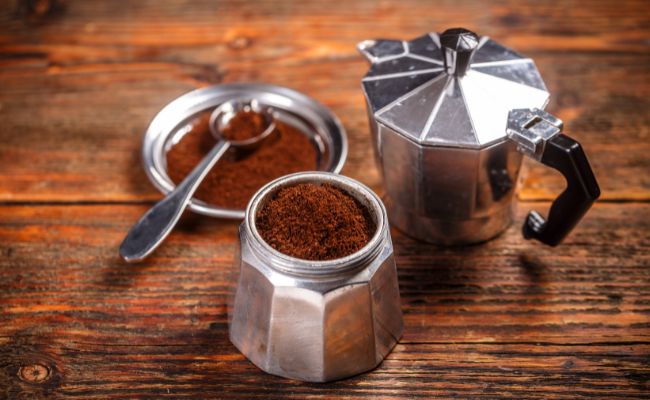Dalgona Espresso Recipe
Why It Works
- Using on the spot espresso packs a great deal of style with out introducing additional water which may skinny the viscosity necessary to hold a significantly regular foam.
- Whisking the espresso mixture with {an electrical} mixer ends in a fluffier, cloud-like foam.
Like quite a lot of the rest of the world, I spent quite a lot of 2020 holed up at home. My core recollections from that 12 months are principally made up of social distancing, intense hand washing, and cooking by the use of the books that had prolonged sat on my shelf. Nonetheless there’s one recipe I take note making repeatedly that 12 months: dalgona espresso.
Made by whisking on the spot espresso, sugar, and scorching water collectively until the mixture resembles a fluffy meringue, the sweet beverage dominated social media feeds that 12 months, piquing the curiosity of a whole lot of hundreds (along with myself) caught at home. It’s no shock the drink was such profitable. Dalgona espresso, which the Los Angeles Events describes as “photogenic Instagram-bait,” was just about engineered for virality: It’s aesthetically pleasing, requires merely 3 substances, and is as similar to a magic trick as a recipe. In a second when most of us couldn’t merely wander proper right down to our favorite café for a cup of joe, attempting the espresso fad appeared…exhilarating.
Extreme Eats / Amanda Suarez
The place Is Dalgona Espresso From?
Dalgona espresso exploded in recognition when the Korean actor Jung Il-woo was filmed attempting the beverage for the first time at Hon Kee Café in Macau and likened it to dalgona candy, a Korean sweet that tastes like toffee. “After I used to be in elementary college, they purchased burnt sugar candy open air [the] college,” Jung says to the digicam. “This tastes like a melted mannequin of that.” Though many people affiliate the drink with being Korean, its roots are lots murkier, as a great deal of cultures all around the world have their very personal mannequin of whipped espresso. In India, there’s phenti hui; in Greece, the frappe; and in Cuba, the café cubano.
Extreme Eats / Lorena Masso
The proprietor of Hon Kee Café, Leong Ham Kon, knowledgeable the Macau Publish On daily basis he picked up the strategy for the drink in 1997 from a pair who visited Macau yearly to attend city’s Grand Prix, though he didn’t try his hand at making the beverage until 2004, when Hong Kong actor Chow Yun-fat visited the café. Eager to impress Chow, Leong made him a cup of the hand-whipped espresso. Chow preferred it lots he knowledgeable Leong it was larger than a couple of of the espresso he’d had at five-star inns. Since then, Leong has been serving the beverage—which he reportedly makes by stirring the second espresso and sugar mixture 400 events by hand!—at his café.
The Science Behind Dalgona Espresso
Let’s start with the basics: Dalgona espresso is a foam. A foam, as Extreme Eats contributor Kevin Liu has written for us, is the dispersion of gasoline proper right into a liquid, like beating air bubbles into egg whites to make meringue, heavy cream to make whipped cream, or a mixture of on the spot espresso, sugar, and water to make dalgona espresso. Throughout the case of meringue, the bubbles are coated and suspended by egg white proteins. In whipped cream, the bubbles are held by the fat molecules of the heavy cream. These protein and fat molecules act as surfactants, which, as Daniel wrote proper right here, sorts a shell throughout the bubbles, stabilizing them.
With dalgona espresso, there’s minimal fat and protein. So what’s performing as a result of the surfactant? Within the occasion you’ve ever seen freshly pulled espresso, you’ve likely seen the crema, a reddish-brown foam that sorts on prime of the shot. Consistent with James Hoffmann, the award-winning barista and creator of Strategies to Make the Most interesting Espresso at Residenceroasting espresso beans produces melanoidins, a foaming agent accountable for crema and cappuccino bubbles. In his dalgona espresso video, Hoffman says he suspects these foaming brokers act as surfactants—the caveat being that surfactants alone don’t make a perfectly regular foam. Depart espresso out for a few minutes, and in addition you’ll see the crema start to dissolve.
Extreme Eats / Lorena Masso
The melanoidin acts as a surfactant by serving to to hold the air bubbles we introduce by whipping; the longer you whip, the smaller the bubbles turn into, resulting in a further regular foam that’s able to keep up its type for longer. Nonetheless the viscosity of the espresso, sugar, and water mixture is important, too, in serving to dalgona espresso preserve its type. Foams, writes gastronomist Hervé This in his e e-book Molecular Gastronomyare “stabilized by rising the viscosity of its liquid half (for example, by together with sugar and glycerol).” The thicker the mixture, the slower your drainage. Briefly, which implies it’ll take longer for any liquid to sink—which is what happens when a meringue weeps.
This will make clear why most dalgona espresso recipes title for equal components by amount of on the spot espresso, sugar, and water. As you’ll see from my recipe below, though, you don’t actually need to make use of a 1:1 ratio of on the spot espresso to sugar. You merely need ample sugar to increase the viscosity of the mixture. Proper right here, I make the most of 2 components espresso to 1 half sugar by amount, nonetheless I don’t counsel reducing the amount of sugar previous this.
Strategies to Make Dalgona Espresso
Listed below are the basic instructions for making dalgona espresso: dissolve on the spot espresso and granulated sugar in scorching water, whisk (each by hand or with {an electrical} mixer) until fluffy and doubled in amount, then dollop it over a glass of milk. Whereas Leong Ham Kon, the founding father of Hon Kee Café, makes his dalgona espresso by hand—stirring until it merely foams—most people, along with myself, need the faster chance of using {an electrical} mixer. You presumably can truly make it by hand, nonetheless the following foam shall be lots softer.
Can You Make Dalgona Espresso With Nicer Speedy Espresso?
Dalgona espresso requires rapid espresso granules, which make it attainable to pack quite a lot of espresso style into the froth with out introducing additional water which may skinny the viscosity necessary to hold a significantly regular foam. Nonetheless on the spot espresso shouldn’t be exactly celebrated for its style. Now, though, there are a selection of extreme espresso roasters moving into the instant-coffee space, moreover with further delicious outcomes.
Curious to see if specialty espresso would foam, Daniel gave my recipe a go along with some on the spot espresso sourced from an artisan roaster. Even after whipping the mixture throughout the bowl of his stand mixer for 14 minutes, the mixture would not keep a gentle foam, quickly collapsing into an un-aerated puddle. “I consider we’ll safely say that specialty espresso acquired’t undoubtedly foam like main on the spot espresso,” he messaged me on Slack.
I can’t say for certain, nonetheless I’ve a hunch about why it won’t have labored. Nicer on the spot coffees are often freeze-dried, which helps to guard the oils that give espresso its rich aroma. Merely as a meringue acquired’t whip as successfully if there’s fat throughout the bowl, it’s attainable that the presence of these oils in freeze-dried specialty espresso make it tougher to whip up. Cheaper on the spot coffees, alternatively, are usually spray-dried: espresso is spritzed into scorching air, which dries it via evaporation, forsaking dehydrated espresso granules.
In a paper printed throughout the Tea & Espresso Commerce JournalDr. Terry Mabbett notes that spray-dried on the spot espresso’s “low-coffee oil content material materials” is what makes it so splendid for foam. Whereas freeze-dried espresso is also further aromatic, the espresso oils present “can quickly stimulate and velocity up the collapse of the foaming course of.”
Extreme Eats / Lorena Masso
That’s to not say that you simply simply couldn’t fiddle in order to make it work, though. It’s attainable some producers of higher-end on the spot espresso might work larger than others. Additionally it is attainable that modifications to the recipe might optimize any particular mannequin of espresso. Together with xanthan gum or gelatin, or manipulating the temperature of the espresso mixture, could help specialty on the spot espresso keep its type. In his video, Hoffmann does deal with to make his dalgona espresso work with nicer on the spot espresso by leaving his mixture throughout the freezer for a variety of minutes to lower the temperature, making it further viscous and less complicated to whip proper right into a foam.
Whether or not or not experimenting in order to make one mannequin of specialty espresso to work is worth it will rely upon how important the usual of the espresso is for you. Within the occasion you’re merely in search of to make a pleasurable caffeinated beverage that takes fewer than 5 minutes from start to finish, you’re most likely larger off merely using plain outdated on the spot espresso.
Consolation aside, I moreover suppose there’s a flavor-based argument in favor of low price on the spot espresso: It usually comes from way more darkly-roasted beans, which have a further acrid, burnt style. Mixed with quite a lot of milk and sugar, that burnt style turns into way more palatable, like burnt caramel… identical to the very dalgona candy Jung Il-woo in distinction the drink to when he took that first viral sip. Probably low price on the spot espresso is how dalgona is supposed to model.
Dalgona Espresso Recipe
Prepare dinner dinner Mode
(Maintain show awake)
-
1/4 cup on the spot espresso granules (1/2 ounce; 14g)
-
2 tablespoons granulated sugar (1 ounce; 30g)
-
1/4 cup (60ml) scorching water
-
Complete or dairy-free milk, for serving (about 1 cup/237ml per serving)
-
Throughout the bowl of a stand mixer fitted with the whisk attachment (you might also do this in a mixing bowl with a hand-mixer; see notes), combine the second espresso granules, granulated sugar, and scorching water. Whisk on medium-high velocity until pale, fluffy, and doubled in amount, about 7 minutes (the froth will begin to kind at about 4 minutes, nevertheless it certainly’s biggest to proceed mixing until a lots fluffier foam sorts at about 7 minutes).
Extreme Eats / Lorena Masso
-
To serve, fill each glass three-quarters of the easiest way full alongside together with your milk of different. Using a spoon, prime each glass with the espresso foam. Serve immediately.
Extreme Eats / Lorena Masso
Notes
The espresso foam could also be made by hand, nonetheless will take longer and won’t be as voluminous as a foam made with a hand or stand mixer. If making the froth by hand: In an enormous bowl, combine the second espresso granules, granulated sugar, and scorching water. Whisk until pale, fluffy, and doubled in amount, about 8 minutes.
Specific Instruments
Stand mixer
Make-Ahead and Storage
The espresso foam is biggest liked immediately; it will deflate and weep if made ahead.




:max_bytes(150000):strip_icc()/20240628-ThaiIcedTea-AmandaSuarez-hero10-20560485c8c2468aab5c065afaa16018.jpg?w=1200&resize=1200,0&ssl=1)
:max_bytes(150000):strip_icc()/SEA-PickleBack-AmandaSuarez-hero1-47d8ad36bd7e46fb80eb316c0416afbd.gif?w=1200&resize=1200,0&ssl=1)
:max_bytes(150000):strip_icc()/20230713-SEA-InfusedWaterHero-AmandaSuarez-005-0f0d8272595a419a892d675a5f9a1e6a.jpg?w=1200&resize=1200,0&ssl=1)